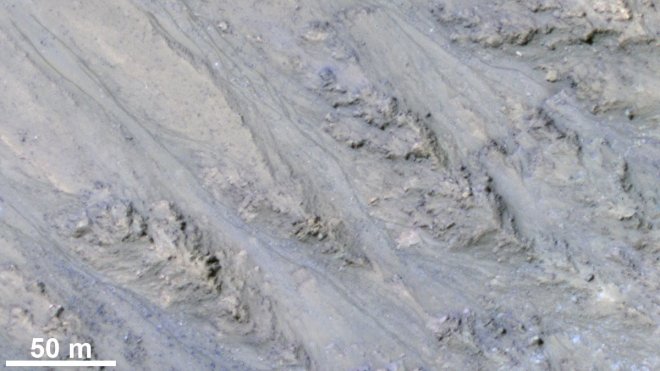
The dark features on Mars which were previously believed to be evidence of running water on the planet has been recently identified as sand grains which flows downhill seasonally.
The research based on pictures from High-Resolution Imaging Science Experiment (HiRISE) camera on the NASA's Mars Reconnaissance Orbiter (MRO) mission found that the features were present only on slopes which are steep enough for the descent of dry grains. The slopes have been found to be similar to the active sand dunes on earth.
The discovery has created a negative impact on the scientific research to find microbial life on the red planet and the mission to create a human settlement on the planet. The researchers, however, have also detected traces of hydrated salts in the flow site which are evidence of small amounts of water.
The research paper published in the journal Nature Geoscience argues that there isn't enough liquid water for survival of microbial life on the red planet. However, it does not explain the origin of these numerous flowing features or its gradual growth.
The discovery of the seasonal flowing feature also known as "recurring slope lineae" or RSL in 2011 had evoked fascination and controversy and had been believed as a marker for liquid water flow or brine in a planet which was otherwise considered as dry. The feature would generally form during the warm seasons and gradually flows to downhill and eventually dry out during winter. This is similar to the seeping water in the Earth. The scientists still wonder the reason for such a natural process in the dry environment of Mars.
Researchers have identified more than 50 rocky-slope areas ranging from the equator to about halfway to the Martian poles. Colin Dundas of the U.S. Geological Survey's Astrogeology Science Center in Flagstaff, Arizona said, "We've thought of RSL as possible liquid water flows, but the slopes are more like what we expect for dry sand. This new understanding of RSL supports other evidence that shows that Mars today is very dry."
The research team led by Colin Dundas created 3-D models of the steep slopes using the HiRISE images of 151 RSL features from 10 different sites.
It was observed that the RSL had been found only in slopes which were steeper than 27 degrees. Each RSL ends in slopes which had "angle of response" similar to sand dunes on Mars and Earth. Liquid water would have readily extended to less steep slopes.
Alfred McEwen, HiRISE Principal Investigator at the University of Arizona, Tucson commented, "The RSL don't flow into shallower slopes, and the lengths of these are so closely correlated with the dynamic angle of response, it can't be a coincidence."
The new study challenges the presence of liquid water on Martian surface in its modern environment. It supports earlier theories that surface of modern Mars which had been exposed to cold, thin atmosphere, lacks flowing water. Another report published in 2016 create doubts about the possibilities of underground water at RSL sites. According to the research, liquid water on Mars would be limited to traces of dissolved moistures from the atmosphere and thin films, which would be challenging to earthly model life.
Scientists, however, are optimistic about the RSL as a unique feature of Mars. They hope that the knowledge of RSL would be important for future exploration of the red planet.
The NASA and other space agencies including private aerospace companies like SpaceX and Lockheed Martin have planned for their manned Mars mission from 2024. This new discovery could form a cloud over the ambitious mission to set up living habitat on the red planet.









